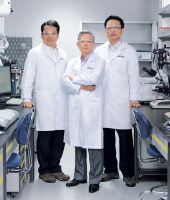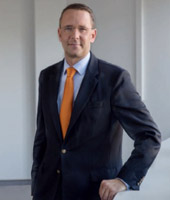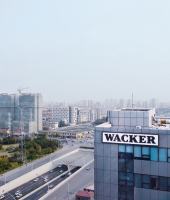Research & Development
WACKER’s research and development pursues three goals.
- Firstly, we search for solutions that meet our customers’ needs and contribute to their market success.
- Secondly, we optimize our processes in order to be the technology leader and to be sustainably profitable.
- Thirdly, we concentrate on creating innovative products and applications for new markets and on serving future trends, such as higher energy requirements, urbanization, digitization and growing prosperity.
R&D Costs
| Download XLS |
|
|
|
|
||||||||||||
|
€ million |
2013 |
2012 |
2011 |
2010 |
2009 |
2008 |
2007 |
|||||||
|
|
|
|
|
|
|
|
|
|||||||
|
Research and development expenses |
173.8 |
173.7 |
172.9 |
165.1 |
164.0 |
163.2 |
152.5 |
|||||||
|
|
|
|
|
|
|
|
|
|||||||
R&D expenses in 2013 came in at € 173.8 million (2012: € 173.7 million). The R&D rate – research and development spending as a percentage of Group sales – was slightly above last year’s figure at 3.9 percent (2012: 3.8 percent).
New-Product Rate (NPR)1

1 Percentage of sales accounted for by products launched in the last five years
We received about € 7.3 million from licensing agreements in 2013 (2012: € 7.1 million). WACKER’s innovative strength is reflected in the number of patents held and patent applications submitted. In 2013, we filed 123 patent applications (2012: 119). Our portfolio contains about 5,500 active patents worldwide, as well as 2,400 patent applications currently pending.
Licensing Income

In 2013, WACKER invested € 5.9 million in R&D facilities (2012: € 8.9 million). This represents a reduction from the previous year, and reflects the end of major capital expenditures from 2012 (totaling € 30 million) on new laboratory buildings, which are now in operation. Investments in 2013 included new pilot plants that we use to scale up project results from the laboratory scale to full industrial-scale production, or to confirm results from simulations. Examples include polysilicon deposition and conversion, as well as electrically active silicone films. We have automated the analytical processes in the Biologics research department, enabling faster analysis of experimental results. New analytical methods have been introduced in our polymer research and we have established laboratory facilities for silicone research to investigate basic processes in the synthesis of methylchlorosilane (MCS). Corporate Research & Development has built laboratory facilities for the production of nanostructured silicon for lithium-ion batteries.
Investment in R&D Facilities
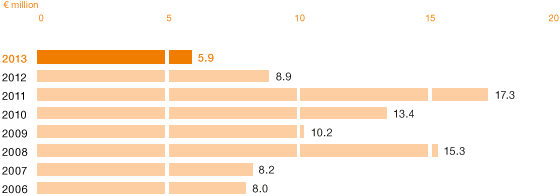
Breakdown of R&D Expenditures

Most of the € 173.8 million (2012: € 173.7 million) in R&D costs was spent on the development of new products and production processes. WACKER scientists are currently working on around 260 projects based on more than 40 technology platforms. More than a quarter of these topics are key strategic projects, which account for 50 percent of all project costs (totaling € 69 million) incurred in 2013. WACKER operates in highly promising fields, ranging from energy, electronics, construction and automotive engineering to household and personal-care products, food and biotechnology. In 2013, we launched the initiative New Solutions. The goal is to develop technically and commercially advanced solutions for new applications. Expertise from various areas in the company is consolidated groupwide and applied to projects as needed. The first projects were initiated in Q4 2013.
We acquired only a small amount of R&D expertise from third parties in 2013, spending some € 170,000 (2012: € 250,000). This amount went to a total of four licensors, with three-fourths used to acquire one particular know-how license, for which we paid € 130,000.
Some of our ongoing research projects in 2013 were subsidized by government grants. Here are a few examples:
- In the MAIspeed project, the German Federal Ministry of Education and Research (BMBF) is funding a subproject in which WACKER is involved. Working with partners from industry and academia, we are doing research on new materials for use in fiber-reinforced lightweight construction in areas such as the automotive industry.
- In the SiHTF project, the German Federal Ministry for the Environment, Nature Conservation, Building and Nuclear Safety (BMUB) is supporting the development of environmentally compatible high-temperature heat-transfer fluids for solar thermal facilities. WACKER coordinates the work being done by the project partners from industry and research.
- In the OPERA project, WACKER SILICONES is working on phosphorescent polymers for LED applications. This project is being supported at a European level by the European Nanoelectronics Initiative Advisory Council (ENIAC), and by the BMBF in Germany.
- In the MAINPAGE joint research undertaking, where WACKER is involved in two projects, the BMBF is funding the development of innovative new materials for industrial photovoltaic applications with enhanced energy efficiency. WACKER POLYSILICON has responsibility for the project aimed at producing granular polysilicon of the highest product quality. Siltronic is leading the research on a continuous, crucible-free pulling process for 200 mm monocrystals with granular silicon.
Our business divisions and Central R&D have submitted applications for six more projects to government sponsors during 2013 with approvals pending. Our externally-funded research projects are coordinated through our Grant Management office, which evaluates candidate programs, submits our project proposals and manages contacts with funders.
Research and Development at Two Levels
WACKER conducts R&D at two levels: centrally at our Corporate Research & Development department and locally at our business divisions. Corporate R&D coordinates activities on a company-wide basis and involves other departments, such as Corporate Engineering (during process development). We also use a portfolio-management process to keep our R&D project portfolio transparent throughout the Group. In 2013, we further optimized the Project System Innovation (PSI) program we use to manage our innovation portfolio and conduct project management. We assess, for example, how we might use the WACKER® Eco Assessment Tool – developed within our sustainability management unit – for innovation projects. When we do research on new products, we use this tool to systematically examine the use of materials, energy and water, and to assess ecotoxicity over the entire product lifecycle. In the 2013 edition of its multi-project management benchmarking study, the Technical University of Berlin has once again ranked our project and portfolio management as one of the top performers.
Strategic Collaboration with Customers and Research Institutes
Our business divisions conduct application-driven R&D. They focus on product and process innovations relating to semiconductor technology, silicone and polymer chemistry, and biotechnology, as well as on new processes for producing polycrystalline silicon. To achieve successful research results more quickly and efficiently, we collaborate with customers, scientific institutions and universities. In 2013, WACKER worked together with more than 40 international research institutes from three continents on 50 research projects.
Our collaborative efforts cover topics such as electricity storage, biotechnology, process simulation and materials research for renewable energy production. Projects include a Central R&D collaboration with the Technical University of Munich and the Fraunhofer organization regarding purification and subsequent methanization of CO2.
WACKER has also created a worldwide network of 22 technical competence centers that liaise between sales offices and local production sites. Specialists in these centers customize products to regional requirements, taking account of climatic conditions, national standards and local raw materials, for example. They develop formulations for customers’ new products, as well as optimize existing recipes.
Research Work at WACKER
As the center of WACKER’s R&D activities, Corporate R&D has the task of researching scientific correlations to develop new products and processes efficiently. Another task is to harness and develop new business fields that complement the Group’s core competencies.
R&D Organization
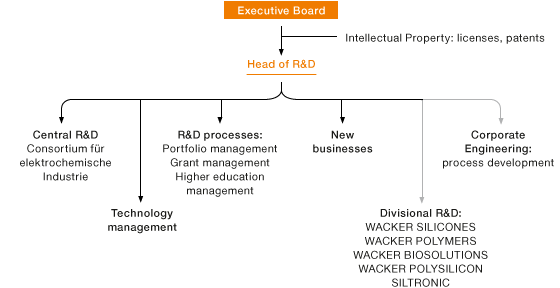
WACKER had 987 research and development staff in 2013, which represents 6.2 percent of the Group’s employees. Our scientists and engineers conduct basic research, develop new products and processes, and improve existing processes. The lab and technical staff at our R&D, applications-technology and production-support facilities work in our laboratories and in our production and pilot plants, or on-site at our customers’ plants. Our other R&D personnel construct research equipment in our workshops, or perform administrative functions in such fields as market research and trend analysis.
Employees in R&D as of December 31, 2013
| Download XLS |
|
|
|
|
||||||||||||||||
|
Number |
2013 |
2012 |
2011 |
2010 |
2009 |
2008 |
2007 |
|||||||||||
|
|
|
|
|
|
|
|
|
|||||||||||
|
||||||||||||||||||
|
Group R&D employees |
987 |
1,008 |
1,100 |
1,057 |
1,072 |
1,078 |
1,038 |
|||||||||||
|
R&D ratio1 in Group (%) |
6.2 |
6.2 |
6.4 |
6.5 |
6.9 |
6.8 |
6.9 |
|||||||||||
|
R&D employees, Germany |
817 |
849 |
868 |
855 |
860 |
836 |
835 |
|||||||||||
|
R&D employees, international |
170 |
159 |
232 |
202 |
212 |
242 |
203 |
|||||||||||
|
|
|
|
|
|
|
|
|
|||||||||||
|
R&D employees, Germany, by qualification |
817 |
849 |
868 |
855 |
860 |
836 |
835 |
|||||||||||
|
Scientists and engineers |
318 |
339 |
346 |
337 |
332 |
311 |
302 |
|||||||||||
|
Lab staff and technicians |
329 |
332 |
350 |
344 |
349 |
345 |
344 |
|||||||||||
|
Other personnel |
170 |
178 |
172 |
174 |
179 |
180 |
189 |
|||||||||||
|
|
|
|
|
|
|
|
|
|||||||||||
|
R&D employees, international, by qualification2 |
102 |
92 |
93 |
95 |
90 |
113 |
66 |
|||||||||||
|
Scientists and engineers |
38 |
32 |
35 |
31 |
30 |
34 |
29 |
|||||||||||
|
Lab staff and technicians |
34 |
32 |
30 |
32 |
29 |
34 |
36 |
|||||||||||
|
Other personnel |
30 |
28 |
28 |
32 |
31 |
45 |
1 |
|||||||||||
|
R&D employees, international, Siltronic AG only (without differentiation by qualification) |
68 |
67 |
139 |
101 |
122 |
127 |
136 |
|||||||||||
|
|
|
|
|
|
|
|
|
|||||||||||
Alexander Wacker Innovation Award
Wacker Chemie AG presented the Alexander Wacker Innovation Award to a project team at Siltronic AG. The team developed a process for manufacturing silicon wafers for high-performance devices. This granular float zone process opens up technological prospects for the custom high-performance wafer market. The € 10,000 Alexander Wacker Innovation Award (named after the company’s founder) has been presented every year since 2005 for pioneering work – alternating between the categories of product innovation, process innovation and basic research.
Siltronic Inventor Award
Siltronic AG confers its Inventor Award on employees who have delivered technological innovations. In 2013, the two categories “Most Important Invention” and “Best Inventor” each awarded € 10,000 in prize money. With their CMP (chemical-mechanical polishing process) and wet-bench cleaning projects, the two winners have optimized processes in the final wafer treatment stages.
Selected Corporate R&D Research Topics
On the topic of energy, we continued our activities in electricity storage and conversion. We are working on materials used in lithium-ion batteries to enhance this type of battery for automotive and consumer-product applications. We are also focusing on lightweight construction, as lighter materials can be used to conserve raw materials and energy, for instance in the automotive and aerospace industries. In these fields, we are developing building blocks for composites.
We have created nanoscale silicon structures and incorporated these in formulations for anodes of lithium-ion batteries using new binders. In tests conducted on batteries with these anodes, we have achieved good stability in charge-discharge cycles: compared with commercially available anodes, these have a much higher specific capacitance. We are also developing new additives in the SafeBatt project, also funded by the BMBF, to improve the safety of lithium-ion batteries.
Selected Divisional Research Projects
WACKER SILICONES launched new silicone rubber foams for use in medical technology and for cushioning. We enhanced our highly transparent liquid silicones for lighting and improved our additives for cosmetic products. We also conducted research on defoaming agents as processing auxiliaries for industrial applications.
WACKER POLYMERS focused its research during 2013 on polymers that enable the formulation of low-emission end products that will meet the requirements of the most stringent ecolabels. We additionally improved our products in the fields of fire-protection and for ensuring safety in road surfacing. In our VAE (vinyl acetate-ethylene copolymer) technology, we worked on new products to meet customer requirements that differ by region. These include high-performance binders that will allow our customers to lower their production costs in Asian markets. We improved our production methods for dispersions and dispersible polymer powders, and developed new technologies for polymer-modified cementitious dry-mix mortars.
In the VINNEX® product family, WACKER enhanced a binder system for bioplastics. With this system, polymers based on renewable resources can now be processed just like standard thermoplastics. The system improves the physical properties of the bioplastics and makes them compatible with each other. These polymer blends have higher impact strength, higher melt strength or better flexibility than conventional biopolymers. Blends formulated with VINNEX® can be processed into items such as food packaging materials, disposable flatware, parts for electronic appliances and self-degradable gardening and agricultural containers.
Wacker Biotech and XL-protein GmbH showed that antibody fragments with substantially extended activity can be produced efficiently using WACKER’s ESETEC® secretion technology and XL-protein’s PASylation®. We custom-developed an efficient bacterial cell line and obtained high yields of the PASylated antibody fragment, which is currently being tested for effectiveness against autoimmune diseases. Working with Metheresis Translational Research, Wacker Biotech developed a cell line based on ESETEC® for producing an antibody fragment for a cancer drug.
At the start of 2014, Wacker Biotech GmbH acquired a BioNet Ventures GmbH production site for therapeutic proteins and its associated business, as well as the Scil Proteins Production company assets located at its Halle site, including its patent portfolio. Scil Proteins Production has expertise in protein refolding that significantly complements WACKER’s know-how as a full-service provider for the microbial manufacture of biologics. For proteins that cannot be produced in an active form in bacterial cells, refolding is a key technology in order to achieve the desired active properties. The acquisition represents a crucial step toward extending our ability to serve our customers once their drugs fully enter the commercial market following successful regulatory approval.
To improve the energy balance of solar cells and lower our costs, we strive to continuously reduce energy consumption in polysilicon production. WACKER POLYSILICON further optimized the processes in its closed production loop. We have thus once again reduced energy consumption during deposition and conversion.
The performance of semiconductor devices doubles about every two years. Among the key performance-boosting parameters are the design rules achieved on a silicon wafer. They determine how many transistors fit on a device per square centimeter. Today, the semiconductor industry’s standard design rules are 22 and 16 nanometers (nm). In the coming years, they will decrease to 11 and eventually 8 nm. We are currently developing processes to produce 300 mm wafers that are used for 11 and 8 nanometer design rules. Siltronic’s first 11 nm products are in customer approval processes. We have evaluated the technology for 8 nm wafers and produced the first experimental products.
Transferring Knowledge Locally
Our WACKER ACADEMY locations serve as a collection of forums for industry-specific knowledge transfer between customers, distributors and WACKER experts. The focus is on industry-specific courses, which now cover silicone applications in addition to polymer chemistry, such as for cosmetics and paints. The training centers’ proximity to our development and test laboratories promotes the sharing of ideas and enables participants to conduct practical on-site tests. We work with company research facilities, universities and institutes to ensure our seminars remain state of the art.
WACKER attaches considerable importance to fostering young scientific talent and maintaining close contacts with universities. In 2013, we sponsored 120 final-degree theses and internships with students at over 50 universities internationally. We additionally sponsored 16 students at the Institute of Silicon Chemistry, which was founded at the Technical University of Munich in 2006 (making for a grand total of 50 students since the founding of the Institute). Seven of these students completed their doctoral theses in 2013 (the Institute has produced a total of 29 doctoral theses since its founding). Two new graduates joined WACKER in 2013 to pursue careers in R&D.
Key Product Launches in 2013
| Download XLS |
|
|
||||||
|
Product |
Description |
Application |
Sector |
|||
|
|
|
|
|
|||
|
BELSIL® ADM 8301 E |
Aqueous macroemulsion |
Hair conditioners, treatments and masks |
Hair-care industry |
|||
|
BELSIL® REG 1100 |
Silicone resin elastomer |
Skin care and color cosmetic preparations |
Cosmetics industry |
|||
|
CAVAMAX® W6 |
Alpha-cyclodextrin |
Substitution of sodium caseinate in coconut milk powder, solid-fat-free vegetarian stabilizer for cake icings or egg-free fillings for confectionery products |
Food industry |
|||
|
ELASTOSIL® Film |
Silicone film |
Packaging; dielectric precision films for sensors, actuators and generators |
Electronics and packaging industry |
|||
|
ELASTOSIL® R 416/70 |
High-temperature-curing solid silicone rubber |
Cost-effective extrusion of fabric-reinforced silicone hoses |
Automotive industry |
|||
|
ELASTOSIL® R 781/80 |
Magnetizable solid silicone rubber |
Molded parts, profiles, hoses; products that can be detected by metal detectors |
Appliance industry, detection systems |
|||
|
ETONIS® 260 |
Dispersible polymer powder |
Concrete modification for road surfacing |
Road, tunnel and underground construction projects |
|||
|
LUMISIL® LR 7600 |
Highly transparent liquid silicone rubber |
Flexible optical lens |
Automotive, lighting and solar industries |
|||
|
SEMICOSIL® 915 HT |
Highly heat-resistant silicone gel |
Encapsulation of power semiconductor modules |
Electronics industry |
|||
|
SILPURAN® 2112 |
Skin-compatible silicone adhesive |
Wound dressings, wound treatment |
Health industry |
|||
|
SILPURAN® 2438 ADH |
Silicone adhesive |
Bonding textiles and composites |
Prosthetics |
|||
|
VINNAPAS® 5111 L |
Dispersible polymer powder |
Self-leveling floorings and smoothing compounds, reduced VOC (volatile organic compounds) |
Construction sector |
|||
|
VINNAPAS® CA 55 |
Dispersion |
Adhesives for carpet backings |
Carpet industry |
|||
|
VINNAPAS® LL 3019 |
Dispersion |
Low-emission paint and plaster applications for interior and exterior use |
Construction and coatings industry |
|||
|
VINNAPAS® LL 3112 |
Dispersion |
Fire-protection coating |
Construction and coatings industry |
|||
|
VINNAPAS® 5518 H |
Dispersible polymer powder |
Strongly hydrophobic binder for joint sealant and plasters |
Construction sector |
|||

